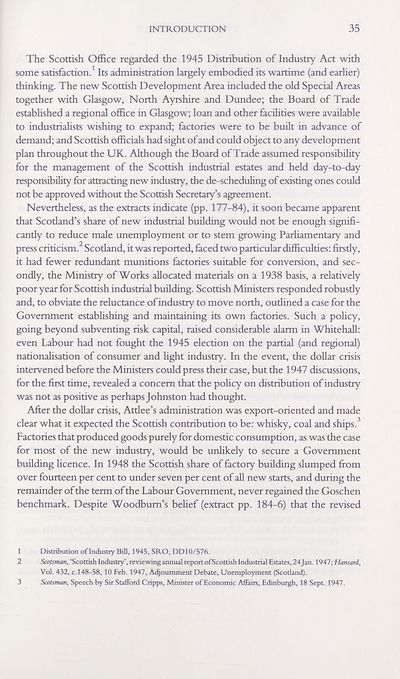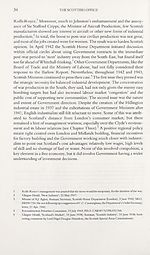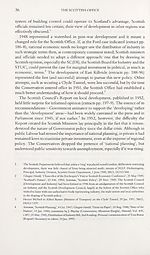Series 5 > Scottish Office
(50) Page 35
Download files
Complete book:
Individual page:
Thumbnail gallery: Grid view | List view

INTRODUCTION
35
The Scottish Office regarded the 1945 Distribution of Industry Act with
some satisfaction.1 Its administration largely embodied its wartime (and earlier)
thinking. The new Scottish Development Area included the old Special Areas
together with Glasgow, North Ayrshire and Dundee; the Board of Trade
established a regional office in Glasgow; loan and other facilities were available
to industriahsts wishing to expand; factories were to be built in advance of
demand; and Scottish officials had sight of and could object to any development
plan throughout the UK. Although the Board of Trade assumed responsibility
for the management of the Scottish industrial estates and held day-to-day
responsibility for attracting new industry, the de-scheduling of existing ones could
not be approved without the Scottish Secretary’s agreement.
Nevertheless, as the extracts indicate (pp. 177-84), it soon became apparent
that Scotland’s share of new industrial building would not be enough signifi-
candy to reduce male unemployment or to stem growing Parhamentary and
press criticism.2 Scotland, it was reported, faced two particular difficulties: firstly,
it had fewer redundant munitions factories suitable for conversion, and sec¬
ondly, the Ministry of Works allocated materials on a 1938 basis, a relatively
poor year for Scottish industrial building. Scottish Ministers responded robustly
and, to obviate the reluctance of industry to move north, outlined a case for the
Government establishing and maintaining its own factories. Such a policy,
going beyond subventing risk capital, raised considerable alarm in Whitehall:
even Labour had not fought the 1945 election on the partial (and regional)
nationalisation of consumer and light industry. In the event, the dollar crisis
intervened before the Ministers could press their case, but the 1947 discussions,
for the first time, revealed a concern that the policy on distribution of industry
was not as positive as perhaps Johnston had thought.
After the dollar crisis, Attlee’s administration was export-oriented and made
clear what it expected the Scottish contribution to be: whisky, coal and ships.3
Factories that produced goods purely for domestic consumption, as was the case
for most of the new industry, would be unlikely to secure a Government
building licence. In 1948 the Scottish share of factory building slumped from
over fourteen per cent to under seven per cent of all new starts, and during the
remainder of the term of the Labour Government, never regained the Goschen
benchmark. Despite Woodbum’s belief (extract pp. 184-6) that the revised
1 Distribution oflndustry Bill, 1945, SRO, DD10/576.
2 Scotsman, ‘Scottish Industry’, reviewing annual report ofScottish Industrial Estates, 24Jan. 1947; Hansard,
Vol. 432, c.148-58,10 Feb. 1947, Adjournment Debate, Unemployment (Scodand).
3 Scotsman, Speech by Sir Stafford Cripps, Minister of Economic Afiairs, Edinburgh, 18 Sept. 1947.
35
The Scottish Office regarded the 1945 Distribution of Industry Act with
some satisfaction.1 Its administration largely embodied its wartime (and earlier)
thinking. The new Scottish Development Area included the old Special Areas
together with Glasgow, North Ayrshire and Dundee; the Board of Trade
established a regional office in Glasgow; loan and other facilities were available
to industriahsts wishing to expand; factories were to be built in advance of
demand; and Scottish officials had sight of and could object to any development
plan throughout the UK. Although the Board of Trade assumed responsibility
for the management of the Scottish industrial estates and held day-to-day
responsibility for attracting new industry, the de-scheduling of existing ones could
not be approved without the Scottish Secretary’s agreement.
Nevertheless, as the extracts indicate (pp. 177-84), it soon became apparent
that Scotland’s share of new industrial building would not be enough signifi-
candy to reduce male unemployment or to stem growing Parhamentary and
press criticism.2 Scotland, it was reported, faced two particular difficulties: firstly,
it had fewer redundant munitions factories suitable for conversion, and sec¬
ondly, the Ministry of Works allocated materials on a 1938 basis, a relatively
poor year for Scottish industrial building. Scottish Ministers responded robustly
and, to obviate the reluctance of industry to move north, outlined a case for the
Government establishing and maintaining its own factories. Such a policy,
going beyond subventing risk capital, raised considerable alarm in Whitehall:
even Labour had not fought the 1945 election on the partial (and regional)
nationalisation of consumer and light industry. In the event, the dollar crisis
intervened before the Ministers could press their case, but the 1947 discussions,
for the first time, revealed a concern that the policy on distribution of industry
was not as positive as perhaps Johnston had thought.
After the dollar crisis, Attlee’s administration was export-oriented and made
clear what it expected the Scottish contribution to be: whisky, coal and ships.3
Factories that produced goods purely for domestic consumption, as was the case
for most of the new industry, would be unlikely to secure a Government
building licence. In 1948 the Scottish share of factory building slumped from
over fourteen per cent to under seven per cent of all new starts, and during the
remainder of the term of the Labour Government, never regained the Goschen
benchmark. Despite Woodbum’s belief (extract pp. 184-6) that the revised
1 Distribution oflndustry Bill, 1945, SRO, DD10/576.
2 Scotsman, ‘Scottish Industry’, reviewing annual report ofScottish Industrial Estates, 24Jan. 1947; Hansard,
Vol. 432, c.148-58,10 Feb. 1947, Adjournment Debate, Unemployment (Scodand).
3 Scotsman, Speech by Sir Stafford Cripps, Minister of Economic Afiairs, Edinburgh, 18 Sept. 1947.
Set display mode to:
![]() Universal Viewer |
Universal Viewer | ![]() Mirador |
Large image | Transcription
Mirador |
Large image | Transcription
Images and transcriptions on this page, including medium image downloads, may be used under the Creative Commons Attribution 4.0 International Licence unless otherwise stated. ![]()
| Scottish History Society volumes > Series 5 > Scottish Office > (50) Page 35 |
|---|
| Permanent URL | https://digital.nls.uk/127346601 |
|---|
| Description | Over 180 volumes, published by the Scottish History Society, containing original sources on Scotland's history and people. With a wide range of subjects, the books collectively cover all periods from the 12th to 20th centuries, and reflect changing trends in Scottish history. Sources are accompanied by scholarly interpretation, references and bibliographies. Volumes are usually published annually, and more digitised volumes will be added as they become available. |
|---|


